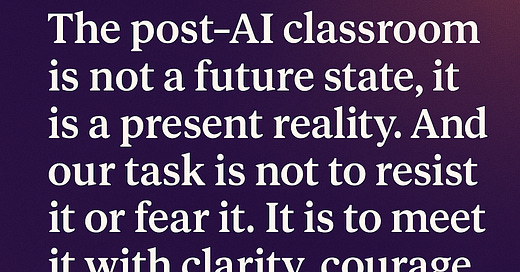Moving from tool adoption to pedagogical innovation in the post-AI classroom
From the first meeting of Lipscomb’s AI Task Force in January of 2024, we’ve focused on thinking about transformation. But, of course, tools do matter, especially when they are chosen with care, shared equitably, and grounded in a purpose beyond productivity.
In my last post, I shared how faculty are rethinking assessment and engagement through their use of AI. Today, I want to go a step deeper and explore the specific tools our faculty are asking for, the vision that is driving them, and how we are already stepping into what some are calling the “post-AI classroom.”
What Faculty Are Asking For
We’ve repeatedly heard a clear and compelling request from faculty: we need a shared, secure, and supported AI platform that allows both students and instructors to experiment, create, and grow together.
As we explored different tool options, a long time English faculty member let me know that he especially liked BoodleBox, because it provided the opportunity to work with a wide array of tools and bots in what he called “a novice-friendly” way. This flexibility, supportive, and secure environment gave faculty the confidence to explore and play with different large language models, use and even build bots, and use AI in their courses and assignments.
That kind of transformation is not just anecdotal. Faculty across disciplines are imagining assignments they could never have built alone, from AI-enhanced debates in online learning, to fashion design students using AI to build moodboards and reframe artist statements, to biology students developing practice exams through thoughtful prompting.
We’ve discovered that creativity is very important to our faculty. They want tools that can help them do new things with their students. They are also thinking about equity. Several faculty noted that without a shared platform, their ability to integrate AI into coursework is limited. If only some students have access to the tools, we risk widening digital divides rather than closing them.
When everyone has access, we can establish clear expectations, model ethical use, and cultivate digital fluency as a shared academic standard, not a secret advantage that only some students have access to.
We’re Not Waiting for the Post-AI Classroom. We’re Already In It.
In her powerful piece on the post-AI classroom, Lipscomb faculty member Sarah Gibson reminds us:
“The post-AI classroom isn’t coming—we’re already in it” (Gibson, 2024).
That resonates deeply with what I see happening at Lipscomb. Our faculty are not passively waiting to see what AI will do to higher education. Instead, they are actively shaping what AI can do in their classrooms.
In our AI Design Labs, instructors have insights into how their role is shifting, but not disappearing. One faculty member shared that after replacing a quiz with an interactive bot, she asked her students, “Do you still think you need a professor?” Their response was clear: “Yes, but in new ways.”
This is the shift that is so vital for us to understand. In the post-AI classroom, faculty are no longer just transmitters of content. They are curators of questions, facilitators of discernment, and mentors in ethical engagement. That is not a loss, but a deepening of purpose. In fact, I would argue that perhaps this shift is allowing faculty to lean further into the core strengths of humanity to become mentors that build learning communities based on empathy, critical thinking and connection.
Tools, Yes. But Always with Purpose.
When our faculty talk about using tools like BoodleBox, they are not just talking about access. Instead, they are talking about the ability to build a culture, one where AI is used not to shortcut learning, but to strengthen it.
Faculty are building assignments that compare outputs from different AI models, guiding students to think critically about bias, accuracy, and source evaluation. They are teaching AI as a literacy, not a novelty. And they are reminding students, by example, that technology is most powerful when used in service of humanity, not in place of it.
This is what it looks like to live into our mission: to love God, seek knowledge, serve others, and pursue excellence with joy. That mission does not change in the age of AI.
Where We're Headed
The post-AI classroom is not a future state, it is a present reality that is becoming even now. As I’ve said before, our task is not to resist it or fear it. Our task is to meet it with clarity, courage, and community.
For academic leaders, it’s vital that we keep listening to what faculty need, keep investing in shared tools that align with our values, and keep walking together into this unmade future, trusting that transformation does not come from the tool itself, but from the people who choose to use it with purpose.
As I’ve shared before, this is not just a tech transition. It is a mindset shift. And I could not be more grateful to be walking this part of the journey alongside our faculty, staff and students as we prepare Lipscomb graduates to lead the future with clarity, compassion, and creativity.




Wonderful overview and insights!